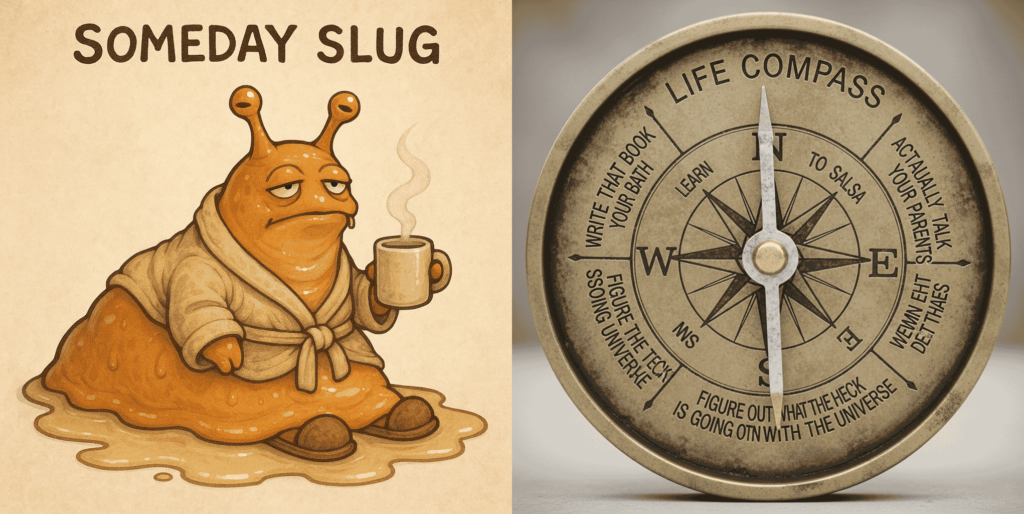There’s a question that lurks in the self-help aisle of the cultural consciousness. It’s a piece of pop-philosophy so common it’s become a cliché. We tend to dismiss it because it feels too dramatic, too simple, too… much.
You know the one:
“What would you do if you had only one year left to live?”
I know, it feels dramatic. Morbid, even. When someone asks it, you’re supposed to look wistfully into the distance, have a profound epiphany, and immediately book a one-way ticket to a far-flung destination.
But here’s the thing: clichés are clichés for a reason. And this question, despite its cheesiness, is actually one of the most powerful diagnostic tools we have for our own lives. It’s a giant, flashing X-ray machine for the soul.
The real magic isn’t in the first part of the question; it’s in the terrifying, brutally honest follow-up:
“So… why aren’t you doing it?”
That’s where it gets uncomfortable. That’s where we stop wistfully thinking about far-flung adventures and start staring at our spreadsheets, our household chores, and the endless queue of shows we’re “meaning to watch.”
The gap between our answer to the first question (our “Terminal Year Plan”) and our answer to the second (our “Actual Life”) is one of the most important things we can ever examine. It’s a measure of the distance between the life we think we want and the life we are actually living.
To understand this gap, we need to meet two characters who live inside all of our brains.
Meet Your Brain’s Roommates
First, there’s your Life Compass.
The Life Compass is the part of you that answers the one-year-to-live question. It’s your core values, your deepest curiosities, your authentic desires. It doesn’t care about your job title or what your neighbors think. It just knows what makes you feel alive.
But the Life Compass has a roommate. And this roommate is a problem.
Meet the Someday Slug.
The Someday Slug is the master of the status quo. Its entire existence is dedicated to one belief: Later is a better time to do things.

The Life Compass says, “Let’s go on an adventure!”
The Someday Slug oozes, “Great idea. We should totally plan that… someday.”
The Life Compass says, “We should tell that person we love them!”
The Someday Slug yawns, “Absolutely. The timing just needs to be perfect. Let’s wait.”
The Life Compass says, “We need to quit this soul-crushing job!”
The Someday Slug pats your hand, “Whoa there, partner. Let’s not be hasty. We have responsibilities. We need security. We can think about our ‘passion’ later, once we’ve saved up a bit more.”
The Someday Slug isn’t evil. It’s just a creature of comfort, fear, and inertia. It’s the part of our brain that evolved to conserve energy and avoid risk. For 99% of human history, the Someday Slug was your best friend. Its motto—“Don’t do anything new, you might get eaten by a tiger”—was a fantastic survival strategy.
But in our modern world, the tigers are mostly gone. And now, the Someday Slug’s prime directive has become a quiet tyranny, convincing us to trade our one, wild, precious life for a state of perpetual, comfortable “not yet.”
The Someday Slug’s Four Favorite Weapons
So why is this slug so powerful? It uses a sophisticated arsenal of psychological weapons to keep your Life Compass locked in a drawer.
1. The Fog of Vagueness.
Your Life Compass often speaks in big, beautiful ideas: “Travel the world!” “Get healthy!” “Be creative!” The Someday Slug loves this. Vague goals are not actionable. “Travel the world” is an intimidating, expensive, and complex project. So the Slug says, “We’ll get to that… someday.” But if you translated that into, “Buy one plane ticket to one city for a four-day trip next month,” the Slug would panic. That’s specific. That’s real. The Slug hates real.
2. The Cult of ‘Responsible.’
Our society is built on a foundation of predictability. We have career paths, retirement plans, and 30-year mortgages. These things are not inherently bad, but they are the perfect habitat for the Someday Slug. The Slug convinces us that being “responsible” means deferring our dreams, and that following our Life Compass is “irresponsible” or “childish.” It’s a master of framing the extraordinary as the reckless.
3. The Time Horizon Illusion.
If you’re 30, you feel like you have forever. If you’re 50, you still feel like you’ve got a good chunk of time. Our brains are not built to intuitively grasp the finite nature of our existence. The Someday Slug exploits this by treating time as an infinite, renewable resource. “Why rush?” it asks. “There’s always tomorrow.” This is its most powerful and most dangerous lie. Because there isn’t always tomorrow.
4. The Fear Amplifier.
The Life Compass points toward change, and change is scary. What if you fail? What if you look stupid? What if you end up broke? The Someday Slug takes these legitimate fears and uses a megaphone. It turns a small risk into a catastrophe. It convinces you that the cozy discomfort of your current situation is far safer than the terrifying uncertainty of the unknown.
How to Gently Evict the Slug
So what do we do? How do we close the gap between our Terminal Year Plan and our Actual Life?
You don’t declare all-out war on the Someday Slug. You can’t. It’s part of you. Trying to fight it with brute force will just exhaust you. The slug is patient. It will wait you out.
The trick is to stop living in the Slug’s world and start making your world inhospitable to the Slug. You have to become a Slug-Evictor. And you do that by listening to your Life Compass, not just once a year when you ponder a morbid question, but every single day.
The process is not about a single, dramatic leap. It’s about a thousand tiny steps.
- Translate the Vague into the Specific. Don’t “travel the world.” Plan one trip. Don’t “write a book.” Write one page. Don’t “get in shape.” Go for one walk. A specific, small action is Slug-repellent. It’s too real, too immediate for the Slug to stop.
- Schedule Your Compass Time. The Someday Slug owns your unstructured time. So, you have to formally schedule appointments with your Life Compass. Put “1 hour of writing” or “30 minutes of learning Spanish” on your actual calendar, just like a dentist appointment. Defend that time mercilessly.
- Shrink the Fear. De-risk your dreams. You don’t have to quit your job to start a business. You can spend $50 on a domain name and work on it for an hour every Sunday. You don’t have to sell your house to travel. You can explore a neighborhood in your own city you’ve never been to. Take the huge, terrifying version of your dream and find its smallest, least-scary version. Do that first.
The one-year-to-live question isn’t about dying. It’s about waking up.
It’s a reminder that your time is not a dress rehearsal. The Someday Slug wants you to believe that your real life will start later. But your life is happening right now, in this exact, un-special, ordinary moment.
The goal isn’t to live every day as if it’s your last. That sounds exhausting. The goal is to live every day with the quiet, humming awareness that it could be. That awareness isn’t meant to be a source of panic. It’s meant to be a source of clarity. It’s the ultimate tool for distinguishing between what’s urgent and what’s important.
So ask yourself the question. And then ask the follow-up. Stare into the gap. Don’t look away.
And then, just for today, take one tiny, microscopic step in the direction your Compass is pointing. Just one.
The Someday Slug will hate it.
And that’s how you’ll know you’re finally on the right track.
